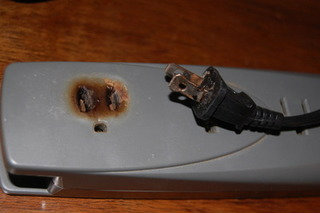Well that's kind of borderline, in the gray area. Yes it should have worked. There are a variety of reasons that could have contributed to the failure. Perhaps the heater plug or power strip socket could have had some corrosion or oxidization, or the power strip plug or wall socket. Perhaps your AC line voltage was low. US standard power is 117-120 VAC but it's not unusual to see it go below 115 or even below 110, particularly if your power distribution grid is overloaded (that's between the power plant and your house). When the voltage drops the current can increase and it's the current that causes damage like yours. (Voltage can also get too high, 125 VAC or more, which is what power surge protectors are used for, the surge they're referring to is a voltage surge. Surge protectors are generally used to protect sensitive electronic equipment from over-voltage conditions.)
In any case you had about a 20%-25% safety margin, and if either the plug strip manufacturer overstated their ratings or the heater manufacturer understated their ratings then there goes your margin. In theory you should have been okay. You probably would have been okay if you'd plugged your heater directly into a wall outlet. But the way things worked out you weren't okay, but at least nobody was injured and the loss was only the heater and power strip.
If in the US you should probably report the incident to the
Consumer Product Safety Commission (CPSC). Also, I think it's quite possible that Amazon may provide a refund or exchange even though it's past the 90 day warranty, for goodwill. I'm sure Amazon does not want to be associated with selling shoddy or dangerous products. Certainly you should contact them and make your complaint known, ASAP.
Thankfully I have all the paperwork, original box that it came in & purchase date.
I to live in California Central Coast area. The grids? Who knows what PG&E is up to. They've already proven to me that they are liars. Don't tell me your here to paint my meter. Shut off my gas and slyly install a smart meter. That's just what they did.
Electralog does have a Limited One Year Warranty.
What I have to do is contact Electralogs techs. Prove the model # proof of purchase, serial #.
I they deem it's a defective heater. I have the following rights at Electralogs sole discretion will either repair or replace such defective product or part without charge. If they can't repair or replace product part is not commercially practicable or in a timely made, Electralog may in lieu of repair or replacement, choose to refund the purcchase price for such product or part.
Limited warranty service will be solely by dealers or service agents of Electralog authorized to provide warranty services.
The purchaser is responsible for removal and transportation of such product or part(and any repaired or replacement product or part) to and from the authorized dealers or service agents place of business.
This warranty does not entitle the purchaser to on-site or in-home services.
Electralog will not be responsible for and the limited warranty services shall not include, any expense incurred for installation or removal of the product or part ( or any replacement product part) or any labour or transportation costs.Such cost shall be the purchaser's responsibility.
What Electralog and it's dealers and service agents are also not responsible for:
In no event will Electralog, or it's directors, officers, or agents, be liable to the purchase or any third party, whether in contract, in tort, or on any other basis, for any indirect, special, punitive, exemplary, consequential, or incidental, maintenance, use, or inability to use the product, even if Electralog or it's directors, officers, or agents have been advised of the possibility of such losses, costs or damages, or if such losses, costs, or damages that exceed the purchase price of the product.
After all that it goes into Jurisdictions, who qualify's and who doesn't. I may have other rights it varies from jurisdiction's.
To file a complaint with anyone I have to have all my ducks in a row.
We were planning on taking it in to a qualified unbiased Electrician, as is, including taking that strip in as well. Ask them what happened here? What needs to be done to correct it? I don't think we can do that now. Have them come out and check that outlet as well. Before we bring it up with Amazon. I think it's only fair to have some back up in writing as added proof that my use of the product wasn't wrong. It's that cord.
Were just going to have to sit back, wait and see how this all goes. If it's proven defective. I will take it up with everybody involved. It wasn't a cheap heater to buy. It was bought in good faith used in the same manner.
Munky.





